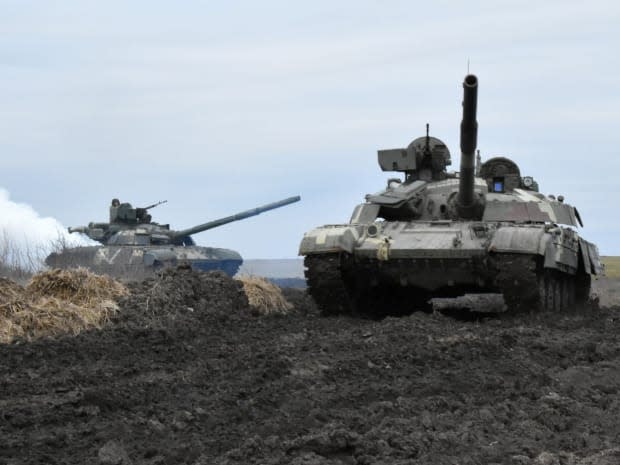What might be behind Putin's latest confrontation with Ukraine

It may have started with U.S. President Joe Biden calling Russian President Vladimir Putin a "killer."
Or Ukraine's president, Volodymyr Zelensky, sanctioning one of Putin's key oligarch allies for "financing terrorism."
Or maybe Putin needed a distraction from domestic problems in Russia.
Whatever the trigger, the Russian president's decision to send tens of thousands of troops and trainloads of tanks, trucks and even ballistic missiles to within striking distance of Ukraine's border has sparked fears of a new Russian attack on its neighbour and left Western leaders scrambling to understand Putin's intentions.
Mobilization comes amid sanctions, proposed summit
The mobilization, which has been building since the third week of March, comes seven years into the still volatile conflict in Ukraine's Donbas region. The area is fractured into territory controlled by Ukrainian government in the west and by pro-Russia separatists in the east, who've declared two breakaway "people's republics" of Donetsk and Luhansk, respectively.
But whereas Russia has always tried to obfuscate its role financing, arming and commanding the separatist fighters, this new military build-up has been out in the open.

Russia has made no attempt to hide who the troops are or what they are doing. The defence minister claims they are part of a "readiness" exercise in response to threatening NATO exercises in Europe,
The deployment of two armies and three airborne formations to western Russia was "a response to the alliance's military activities threatening Russia," Defence Minister Sergei Shoigu said.
But doubts persist that Russia intends to send the troops back home any time soon. Earlier in the week, NATO chief Jens Stoltenberg described the moves as "the largest massing of Russian troops since the illegal annexation of Crimea in 2014."
On Tuesday, at the start of a head-spinning 48 hours of diplomatic developments, Biden suggested meeting with Putin to try to calm tensions.
Then Thursday, with the Kremlin still pondering the offer, Biden's administration hit Russia with a series of new economic, political and diplomatic sanctions as punishment for a massive cyber espionage campaign and interfering in the 2020 presidential election.
WATCH | Biden announces new sanctions on Russia:
'Pause button'
With the possibility of the leaders' summit proposed by Biden still alive, immediate concerns of a new military conflict seem to have eased — but have not been dispelled entirely.
"We have hit a pause button," said Roman Waschuk, a now retired Canadian diplomat whose last assignment was Canadian ambassador to Ukraine from 2014 to 2019. He also served at the Canadian embassy in Moscow and has decades of diplomatic experience in the region.
"In buying several weeks or months of time and potentially re-channeling Russian ambitions in a different direction, it's probably a good thing. The truly dangerous moment would be when they paint themselves into a corner where only military action .. would justify everything they have been doing."

A senior Ukrainian defence official said Thursday he believes by this weekend, Russia will have more than 110,000 troops within striking distance of Ukrainian territory.
Many of them are already stationed in temporary bases near the southern Russian city of Rostov-on-Don.
Further to the south, social media video has shown trains loaded with howitzers and self-propelled artillery crossing the bridge across the Strait of Kerch that connects Russia with the disputed Crimean peninsula.
Other footage has shown Russian warships being repositioned from ports in the Baltic Sea and Caspian Sea to new staging areas on the Sea of Azov, adjacent to Ukraine.
WATCH | Russian ships near Rostov-on-Don on their way to the Black Sea:
Pressure tactic to force concessions
"Psychologically, they want to humiliate Ukraine," said Gustav Gressel, senior policy fellow with the European Council on Foreign Relations in Berlin.
"They want to pressure Ukraine into making political concessions they can use to run the country from behind. That's what the entire war effort has been about."
The Kremlin's official position is that it expects Kyiv to fulfil the terms of the so-called Minsk agreements, signed under pressure by Ukraine in 2015 when the war in Donbas was going badly.
The arrangement calls for special status for the breakaway regions of Donetsk and Luhansk, where Russia has given out more than 500,000 Russian passports. Many Ukrainians believe Russia's real intention is to use that status to block Ukraine's aspirations for closer relations with Europe or one day joining NATO.
Zelensky had managed to keep a shaky ceasefire in place along the line of contact for the past year, but in January, it began to fray.

Since then, 29 Ukrainian soldiers have been killed by snipers, mines or shelling from the separatist side, according to the Ukrainian military. It's unclear what the casualties may be on the opposing side.
As the violence surged, Kremlin officials accused Ukraine of mobilizing its own military to recapture the territory, but Zelensky says there's been no troop build up.
At the same time, and as a further irritant to Putin, Zelensky also shut down several pro-Kremlin TV stations operated by Putin ally Viktor Medvedchuk and accused him of treason.
"So far, the Ukrainian authorities have avoided taking concrete steps toward a peaceful settlement of the situation in the Donbas," said Foreign Ministry spokeswoman Maria Zakharova.
"Increasingly, Kyiv is promoting slogans about 'a Russian threat' while it is the Ukrainian troops who are increasing their presence near the contact line."
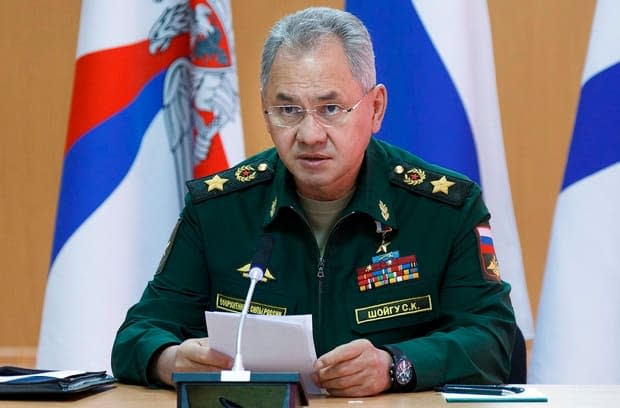
Anti-Ukraine propaganda on Russian state TV
In the meantime, Russian state TV has been saturated with anti-Ukrainian rhetoric and propaganda, possibly to prepare the Russian public for some sort of military operation.
On Sunday, top propagandist Dmitry Kiselyov appeared to suggest if an attack comes, it would be supporting a noble cause as Ukraine has become what he called a "Nazi state."
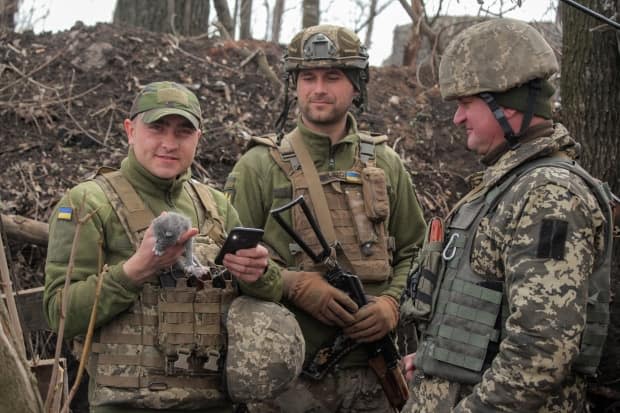
He said since its "denazification" was not happening voluntarily, it needed to occur by force.
"This brinkmanship on the edge of war is a very, very dangerous and risky game," said Aleksander Golts, a Moscow-based journalist who has spent a long career covering Russia's defence and military.
"I see the possibility when you mass troops from both sides — one army against the other — you cannot guarantee that any accident will not happen."
Both Canada's foreign and defence ministers have spoken to their Ukrainian counterparts in recent days and expressed support for Ukraine and its territorial integrity.
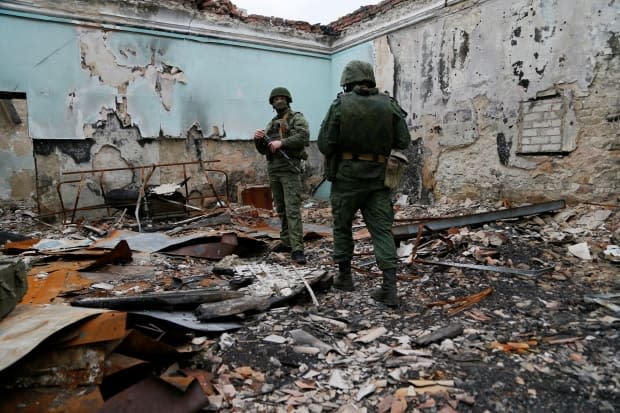
But unlike several of NATO's smaller members, including Latvia, Estonia and Lithuania, Canada has stopped short of advocating for Ukraine's full membership in the alliance.
"I would suspect the current idea is that you don't need to antagonize the Russians by overtly waving around a position that a number of other NATO allies won't allow to happen in the short to medium-term anyway," said Waschuk, the retired Canadian diplomat.
Canada's role
Since 2015, Canada has had roughly 200 troops on the ground in Ukraine as part of Operation Unifier — although it temporarily withdrew some of them last year because of COVID-19.
Its mission has been to upgrade the professionalism of Ukraine's army, which has in turn helped improve its overall capabilities, but Waschuk says against the might of Russia, Ukraine remains a significant underdog.
"The Ukrainians know that, militarily, they are not a direct one-on-one match for the Russians. All they can aspire to do is to make any military action as painful as possible for the Russians," said Waschuk.
The next moves in the stand-off may become clear as early as next week.
On April 21, Putin will deliver his annual address to Russia's federal assembly and may have more to say about the situation.
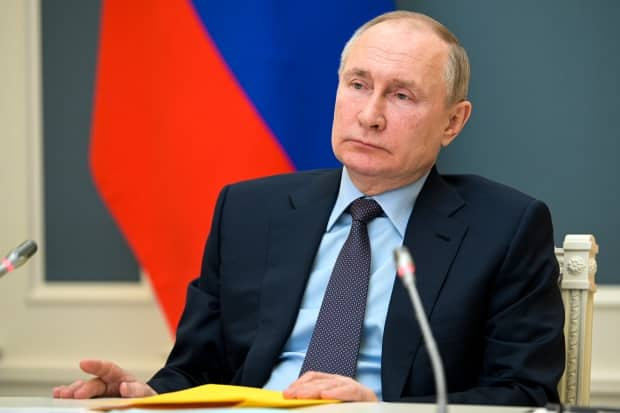
Muddy battlefield
Beyond that, Russian military analyst Pavel Felgenhauer told CBC News that he thinks flooded fields, swollen creeks and muddy roads in the potential battle zone in Eastern Ukraine make a Russian invasion unlikely — for the moment.
"But by mid-May, the fields and dirt roads will dry up and a big war around Donbas will be possible again."
Gressel, with the European Council on Foreign Relations, says in the coming days and weeks, he believes Putin will be assessing the reaction of the U.S. and Europe before he commits to any course of action.
"I think the Russians are struggling to guess how far we would go to support Ukraine."
Which is why, he says, Thursday's announcement about increased U.S. sanctions on Russia is significant.
It's a sign, he said, that Western allies are willing to hold Russia responsible for its actions and sends a message: "If you do something further in Ukraine, we will make you pay for it."
